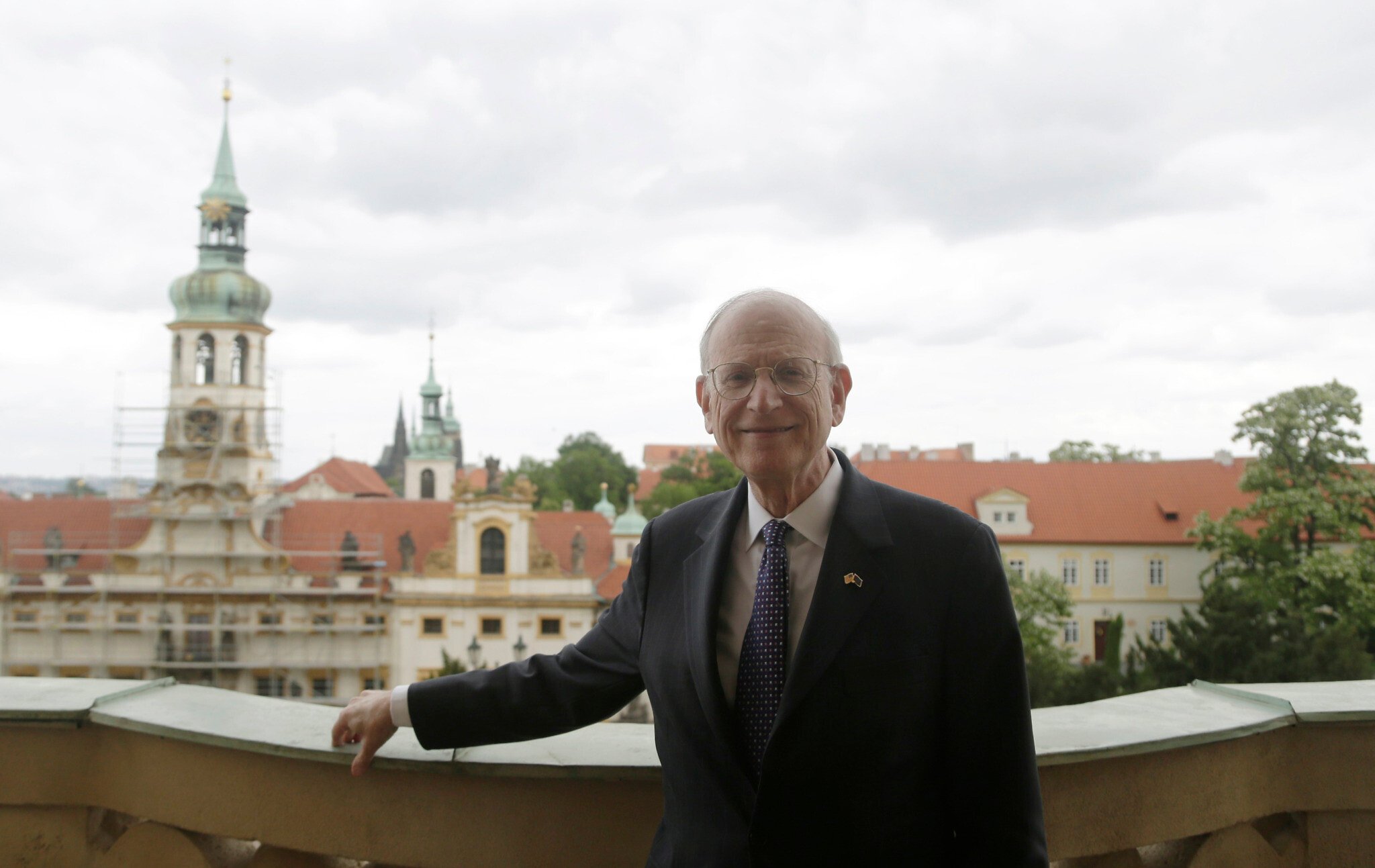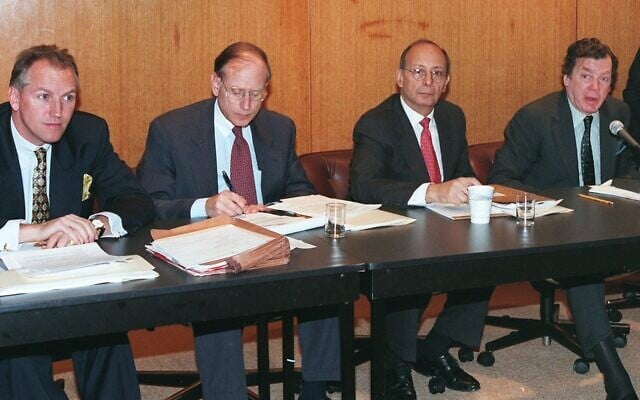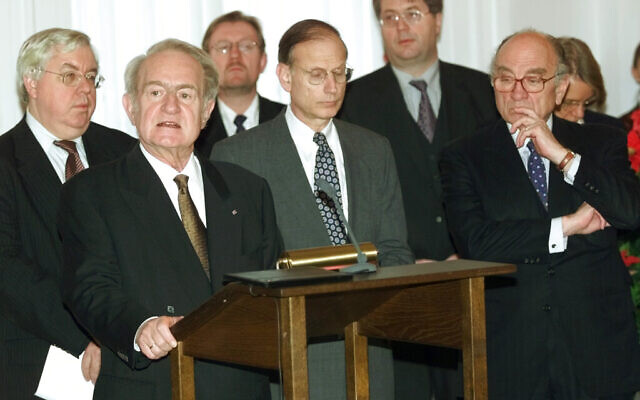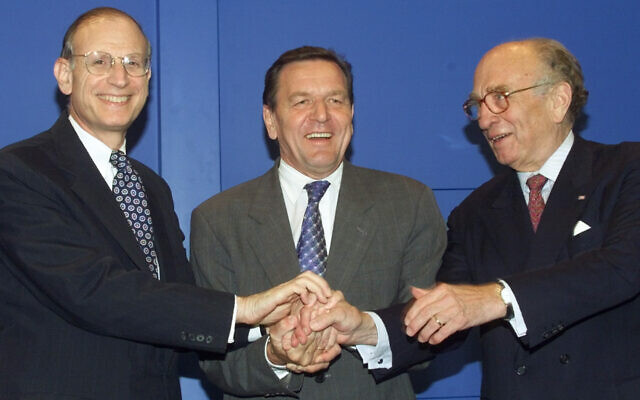



There is, presumably, a very short list of books on diplomacy that contain the following footnote: “I negotiated this agreement with Israel.”
But you can find it — an addendum to the Camp David Accords regarding Israeli airbase construction and crude oil supplies — on page 454 of longtime Jewish-American negotiator Stuart Eizenstat’s latest book, “The Art of Diplomacy: How American Negotiators Reached Historic Agreements That Changed the World,” published by Rowman & Littlefield.
“I tried to show the history of the most important agreements of the last 50 years,” Eizenstat told The Times of Israel via Zoom, “illustrating history in a way I think average readers will like.”
The book achieves this through Eizenstat’s firsthand experience working in the White House under Democratic and Republican administrations, as well as by his interviews with 130-plus US and international power brokers — including former president Bill Clinton and the late US ambassador to Israel Martin Indyk. Quite a few interviewees are Israelis connected to Mideast peace negotiations, with ex-prime ministers Ehud Barak and Ehud Olmert topping a list that also features Tzipi Livni, Yossi Beilin and Itamar Rabinovich.
“I try to bring the reader into the negotiating room, get a feel for the personalities and obstacles and how they were overcome,” Eizenstat said. “It’s not just a dry recitation. I hope it will give the reader an impression of how difficult these negotiations can be — how rewarding when they’re successful and how much of a negative effect there can be if they’re unsuccessful.”
In 12 chapters, Eizenstat dishes on lessons learned from deals and near-deals that sought to end numerous conflicts — the Vietnam War, the Balkan wars, and the US wars in Iraq and Afghanistan among them.
In a chapter on Iran, he recalls a situation room conversation led by his first White House boss, Jimmy Carter, trying to resolve the hostage crisis following the 1979 Islamic Revolution.
According to the book, Eizenstat was among those advocating military action, but Carter said no, which the author called a mistake. The chapter later turns to the 2015 JCPOA nuclear agreement under Barack Obama, abandoned by Donald Trump.
The subsequent chapter, on the overall Middle East, addresses a half-century’s worth of crises and negotiations, many involving Israel, from the Yom Kippur War to the Abraham Accords, as well as the October 7 attacks and the ensuing Israel-Hamas war.
“I talk about the common skills necessary for successful negotiators,” Eizenstat said.
One skill is “securing a historical moment,” like Sadat going to Jerusalem or Mohammed bin Zayed of the United Arab Emirates signing on to the Abraham Accords.
Regarding October 7 and its aftermath, the author laments a missed lesson from history: “One of the big mistakes from the second Iraq war was pushing out Saddam Hussein without first knowing what the political situation was going to be after the war. It’s critical, before you intervene, to have figured out how you put a new government in place” — a mistake that Israel has made “to this day, in its postwar plans for Gaza.”
The book is not limited to discussing conflict. It includes diplomatic deals on trade and climate change and — a cause close to Eizenstat’s heart — Holocaust issues, on which he has played a prominent role since his days in the Carter administration.
Time and again, Eizenstat has been in “the room where it happened,” to quote Hamilton. He’s done so as Carter’s chief White House domestic policy adviser; in various posts under Clinton — ambassador to the European Union, undersecretary of commerce and state, and deputy treasury secretary; and through working on Holocaust issues under the Carter, Clinton, Obama, Trump and Biden administrations.
The presidential achievements of Carter, who died late last year, included the Camp David Accords between Israel and Egypt, which are discussed in the book. On C-SPAN, Eizenstat recalled a home visit from Carter for the Passover seder after the accords.
“Here we are reading about the Jews leaving Egypt 2,500 years ago,” Eizenstat told C-SPAN. “Here’s the man who made peace between Egypt and Israel. It was very emotional.”
The book incorporates Eizenstat’s wider, improbable life trajectory: A Jewish kid who knew no Holocaust survivors growing up in Atlanta and who didn’t study the Shoah in high school or college because no such classes existed wound up involved in some of the most consequential Holocaust negotiations of the late 20th century.
The spark: “While Six Million Died,” a groundbreaking book that laid out US government inaction on the Holocaust. Its author was Arthur Morse, a colleague of Eizenstat’s on the 1968 presidential campaign of Hubert Humphrey. While Humphrey lost, Morse and his book had a lifelong effect on the young campaign staffer.
There is a through line from Eizenstat’s years in the Carter White House to the current US Holocaust Memorial Museum: Dating to 1993, the museum was successfully recommended by a presidential commission on the Holocaust, headed by Elie Wiesel. That commission was called for over a decade earlier, in a memorandum from Eizenstat to Carter.
As for the billion-plus-dollar settlement between Swiss banks and Holocaust victims’ families negotiated under the Clinton administration? Eizenstat worked tirelessly on it, as well as on contemporaneous restitution settlements with the German government and German private industry, France, and Austria. In the book, he compares negotiating with Swiss banks to being “in the middle of a four-cornered boxing ring” that also involved a US audit commission, the World Jewish Congress and class-action lawyers. Weathering the rhetorical punches, he helped win a $1.25 billion settlement for victims’ families.
“I have been haunted… by the loss of six million of our brethren,” Eizenstat said. “It’s not just numbers. It’s the accomplishments that were lost, the music not written, the books not done, the experiments not accomplished, the average lives that could have been lived. It’s something that really is haunting me. Here I am, 81 years old, and I’m still doing this.”
Eizenstat got the seed of inspiration for his latest book through his 2018 biography “President Carter: The White House Years.”
“My editor and publisher said, ‘You know, some of the most interesting parts of the book are about the negotiations that occurred, some of which you were involved with.’” An impromptu book proposal emerged: “I had done a previous book, ‘Imperfect Justice: Looted Assets, Slave Labor and the Unfinished Business of World War II’, about Holocaust negotiations. He said, ‘Why don’t you… do a book more generally about negotiations and how you achieve success?’”
Over the next four years, from 2019 to 2023, Eizenstat filled his calendar speaking with a who’s who of influential American and international statesmen and women.
Some had been heads of state: Clinton, former British prime minister Tony Blair (who sat for two interviews), Barak and Olmert, and previous Taoiseach, or prime minister, of Ireland Bertie Ahern. Some were former secretaries of defense, or ex-CIA directors, or onetime ambassadors — and almost every living secretary of state, including Condoleezza Rice, Hillary Clinton and Antony Blinken.
Only Mike Pompeo said no. “He told me he was working on his own book and couldn’t do it,” Eizenstat recalled. (The book was published before Marco Rubio took office under the Trump administration.)
Clinton’s vice president Al Gore talked with the author about the Kyoto negotiations on climate change, in which both participated — Gore for one day, Eizenstat for the entire summit. The discussions went on too long, exceeded their allotted time, and the air conditioning was shut off. Eizenstat then threatened a walkout, which proved a successful negotiating tactic. Trump’s trade representative Robert Lighthizer discussed economic agreements with Canada and Mexico, as well as tariffs, notably against China. Lighthizer shared three tips for successful negotiation: “preparation, preparation, and preparation.”
Two previous secretaries of state — Henry Kissinger, who died at age 100 in 2023, and James Baker — each spoke with Eizenstat multiple times. Kissinger wrote the foreword, Baker the preface.
“The term ‘shuttle diplomacy’ comes from Kissinger,” Eizenstat noted. “Over two weeks [in 1974], he was traveling from Egypt to Syria to Israel.” As he explained, “International negotiations are really like a marathon, with a sprint at the end… Jimmy Carter got two hours of sleep a day at Camp David over 13 days.”
Readers may lose some sleep while staying up late to finish this book, as the author details the lengths negotiators went to seal the deal — which Carter did on the final day at Camp David.
“Prime minister Begin told president Carter at his cabin, ‘Mr. President, I’ve made all the compromises I can make, I can’t make any more.’” Eizenstat remembered. “He had a limo to Andrews Air Force Base and a plane waiting.”
Failure would have been “a blight on the president’s own record,” Eizenstat said. “A preparatory reading of detailed CIA profiles of Sadat and Begin showed that Begin had a soft spot in his heart for his eight grandchildren. The president asked his personal secretary to make eight copies of the original photo of the two leaders from the first day.
“He wrote the name of each of Begin’s eight grandchildren [on each photo], walked over and handed” them to Begin, Eizenstat recalled. “Tears were coming from Begin’s eyes, his lips were quivering. He said, ‘Mr. President, for my grandchildren, I’ll make one more try.’”




